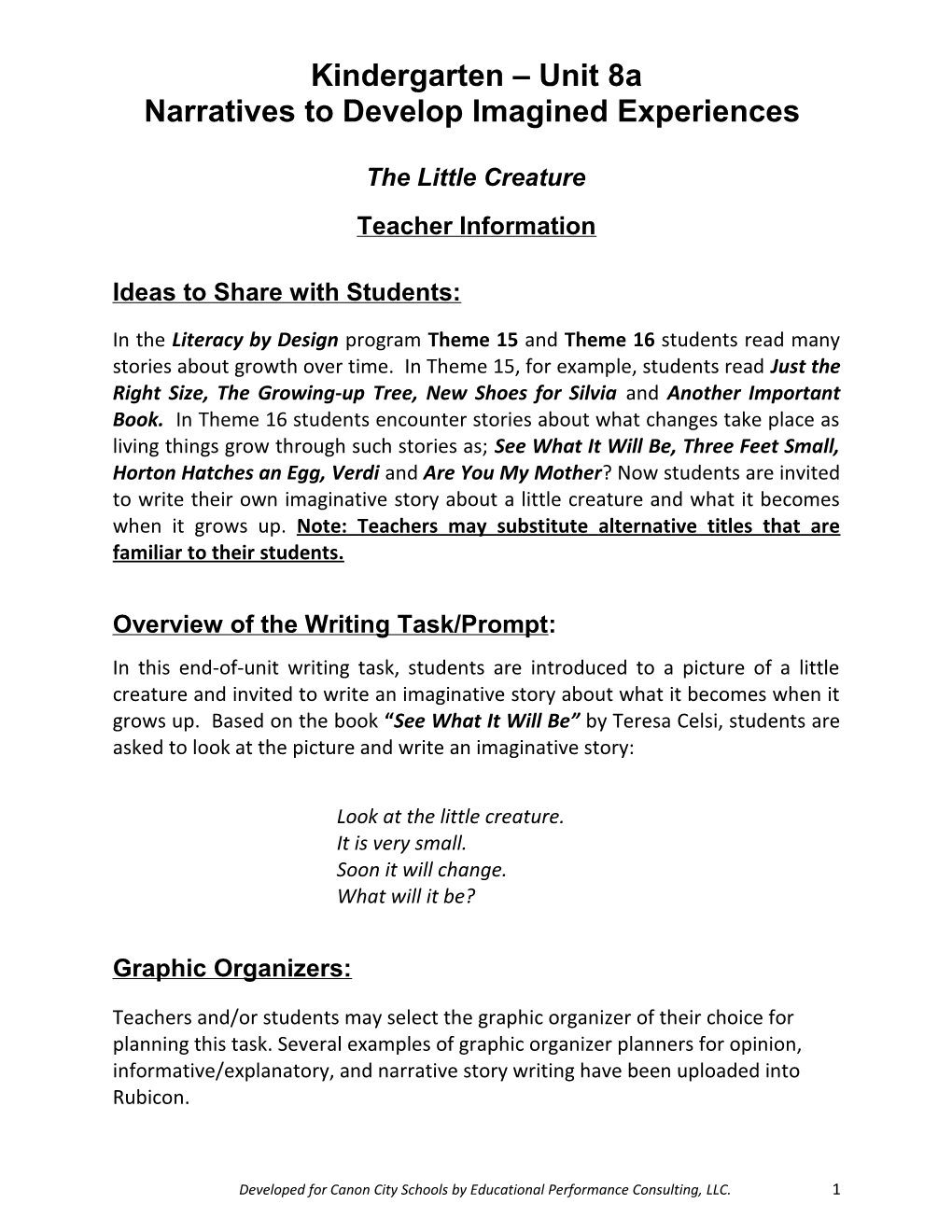Kindergarten – Unit 8a
Narratives to Develop Imagined Experiences
The Little Creature
Teacher Information
Ideas to Share with Students:
In the Literacy by Design program Theme 15 and Theme 16 students read many stories about growth over time. In Theme 15, for example, students read Just the Right Size, The Growing-up Tree, New Shoes for Silvia and Another Important Book. In Theme 16 students encounter stories about what changes take place as living things grow through such stories as; See What It Will Be, Three Feet Small, Horton Hatches an Egg, Verdi and Are You My Mother? Now students are invited to write their own imaginative story about a little creature and what it becomes when it grows up. Note: Teachers may substitute alternative titles that are familiar to their students.
Overview of the Writing Task/Prompt:
In this end-of-unit writing task, students are introduced to a picture of a little creature and invited to write an imaginative story about what it becomes when it grows up. Based on the book “See What It Will Be” by Teresa Celsi, students are asked to look at the picture and write an imaginative story:
Look at the little creature.
It is very small.
Soon it will change.
What will it be?
Graphic Organizers:
Teachers and/or students may select the graphic organizer of their choice for planning this task. Several examples of graphic organizer planners for opinion, informative/explanatory, and narrative story writing have been uploaded into Rubicon.
The Little Creature:
Supporting Students in Becoming Independent Writers:
As students develop their narrative writing skills, they may benefit from using a narrative self-assessment checklist. The following is one example of such as checklist that aligns with the Kindergarten CCSS Narrative Writing Standards. Teachers may design their own self-assessment checklist for students or add pictures in place of the words for beginning writers.
Kindergarten Narrative Self-Assessment ChecklistI use pictures and words to tell a story.
NOT YET / STARTING / YES!
Introduction* (W.K.1) / At the beginning of my writing I told, drew and wrote what my story will be about. / / /
Organization (W.K.1) / My story had a page or part for the beginning, a page or part for the middle, and a page or part for the end. / / /
Elaboration
(W.K.1) / I told, drew and wrote about who was there, what they did, and how the characters felt. / / /
Transitions (W.K.1) / I put the events in order. / / /
Conclusion* (W.K.1) / I told, drew and wrote an ending for my story. / / /
Task Focus / I told, drew, and wrote a whole story. / / /
Grammar Usage (L.K.1) / I used words correctly to help the reader understand my writing. / / /
(L.K.1f) / I used complete sentences. I used different kinds of sentences to make my writing interesting. / / /
Punctuation (L.K.2) / I put spaces between my words. / / /
I used lowercase letters unless capitals were needed. / / /
I wrote capital letters to start every sentence. I wrote a capital I for the word I. / / /
Spelling
(L.K.2) / I could read my writing. / / /
I wrote a letter for the sounds I heard. / / /
I spelled no excuse words correctly. / / /
*Exceeds Kindergarten Narrative Writing Expectations
Adapted by East Otero School District, La Junta, CO from the work of Lucy Calkins’ Units-of-Study
Developed for Canon City Schools by Educational Performance Consulting, LLC. 1
